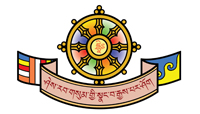|
 |
chos sku drug pa rdo rje 'chang chen po |
|
“The illustrous one, Vajradhara, who is said to possess the eight good qualities,
Is seen in human form by ordinary men like us.
You are the refuge called Padma, endowed with blessings.
I supplicate you not to be separate even for an instant.”
-- Jamgon Kongtrul Lodrö Thaye the Great, The Song of Lodrö Thaye
Vajradhara is the Sanskrit term for the Primordial Buddha, who is the quintessence of Buddhahood. His name was translated into Tibetan as Dorje Chang, “Vajra-holder” in English. Vajra means “indestructibility,” i.e., “skilful means or compassion,” rdo-rje in Tibetan. Dhara in Sanskrit means “to uphold,” ‘chang in the Tibetan language. Chen-po in his full name in Tibetan means “the great one.”
Vajradhara Buddha is depicted dark blue in colour and adorned with meaningful ornaments and garments that each symbolize specific qualities of enlightenment that ceaselessly emanate to benefit and fulfil the needs of living beings. He represents the all-embracing and ever-present Buddha nature that Prince Siddhartha realized when he attained enlightenment under the Bodhitree in Bodhgaya, India more than 2,500 years ago and out of deepest compassion revealed when he turned the Wheel of Dharma three times for the welfare of every living being, the first time at Sarnath.
Buddhist cosmology states that 1000 Buddhas will appear in our most fortunate aeon. Fortunate aeon refers to the fact that a Buddha has come into the world, the holy Dharma is being taught, the Dharma teachings are accessible, all the present Dharma is being followed, and there are beings who compassionately care for one another. The first three Buddhas of our present aeon were Buddha Kakusandha, Buddha Konagamana, and Buddha Kassapa. Buddha Gautama is the fourth Buddha in this aeon of good fortune.
A Buddha’s realization of the wisdom of enlightenment is called dharmakaya (the Sanskrit term that was translated into Tibetan as chös-sku, “the truth body that is free of constructs”). When manifested through subtle symbols, a Buddha’s realization is called sambhogakaya (longs-spyöd-zdzogs-pa’i-sku in Tibetan, “the body of enjoyment”). His appearance is called nirmanakaya (sprul-sku in Tibetan, “the manifestation body”) when emanated in a more accessible physical form, such as an historical Buddha who can readily be appreciated, acknowledged, and fully respected as a spiritual master and guide who teaches ordinary beings how to tame and train their minds and realize the enlightened qualities of Buddhahood.
In the absence of an historical Buddha there are different types of spiritual masters who help students tread the path to enlightenment and therefore are not separate from Vajradhara Buddha. The first type has eight qualities: ethics of a Bodhisattva, vast knowledge of the Bodhisattva texts, realization, great compassion, fearlessness, patience, a completely untiring mind, and skilful speech. The second type has four qualities: good knowledge of the Sutras and profound treatises, wisdom that cuts through disciples’ hesitations and doubts, his words are worth holding on to because he has the conduct of a holy being, and the ability to point out the afflicting emotions and teach their antidotes to students. The third type must have at least two qualities: knowledge of the meaning of the Mahayana teachings and not even for the sake of his life would he forsake the excellent behaviour of a Bodhisattva. On this basis and next to having many other qualities, the Vajrayana spiritual master needs to have received the empowerments of the Oral Transmission Lineage, be expert at teaching the creation and completion phases of meditation practice, and have kept his Bodhisattva vows.
Vajradhara Buddha is the Sambhogakaya Buddha. He is the well-spring and source of all meaningful qualities and activities of enlightenment and therefore he is central to every disciple of the Kagyü Lineage. The great Mahasiddha Tilopa, forefather of the Golden Rosary, received the “indestructible diamond-like” Vajrayana instructions directly from Vajradhara Buddha before he transmitted them to his worthy disciples, and therefore the Golden Rosary of the Kagyü Lineage originated from the very quintessence of Buddhahood – that always was and ever will be the true and pure legacy of all living beings.
May goodness and virtue increase!
(Compiled and written by gh, solely responsible for any mistakes.)
